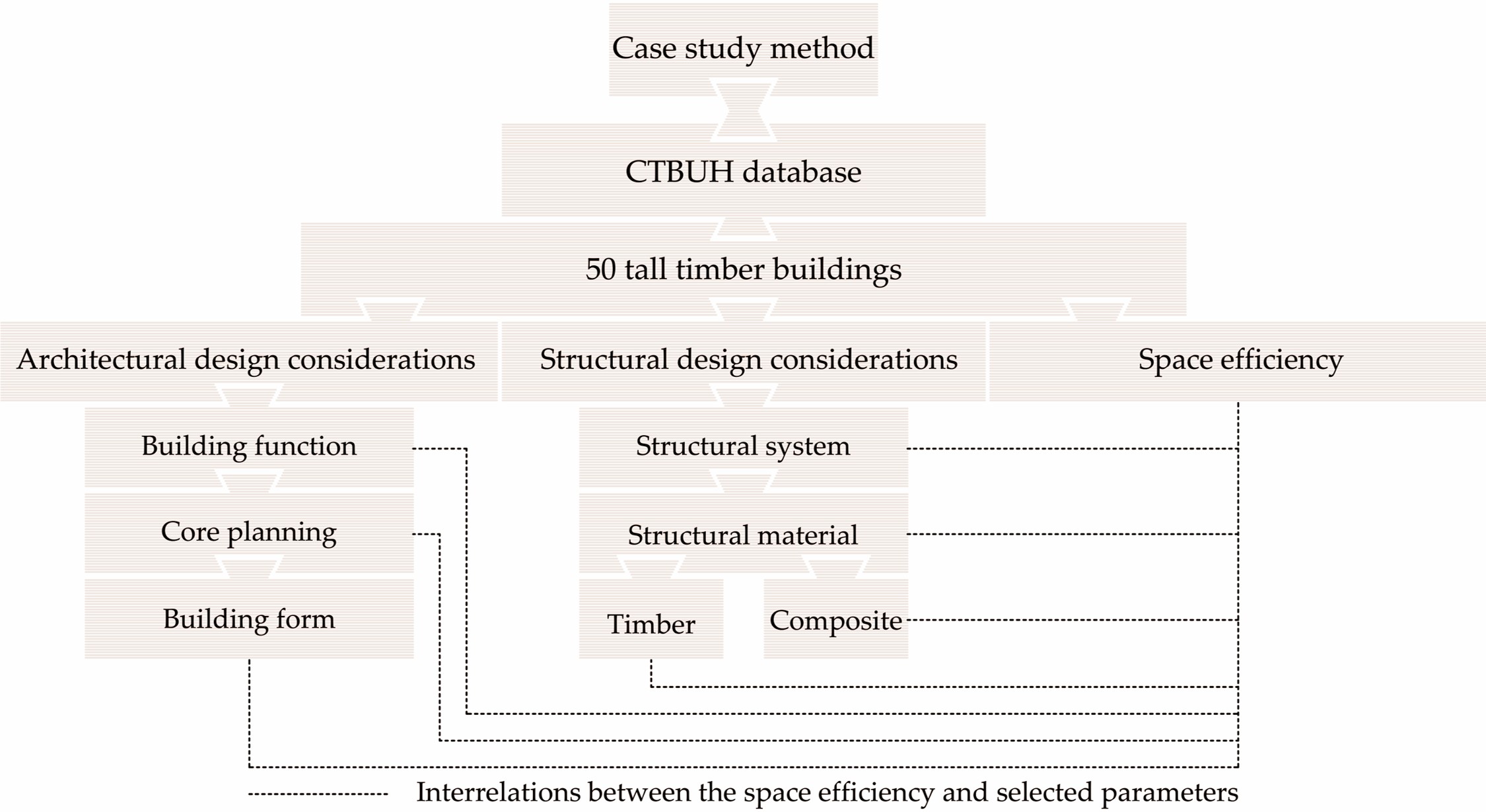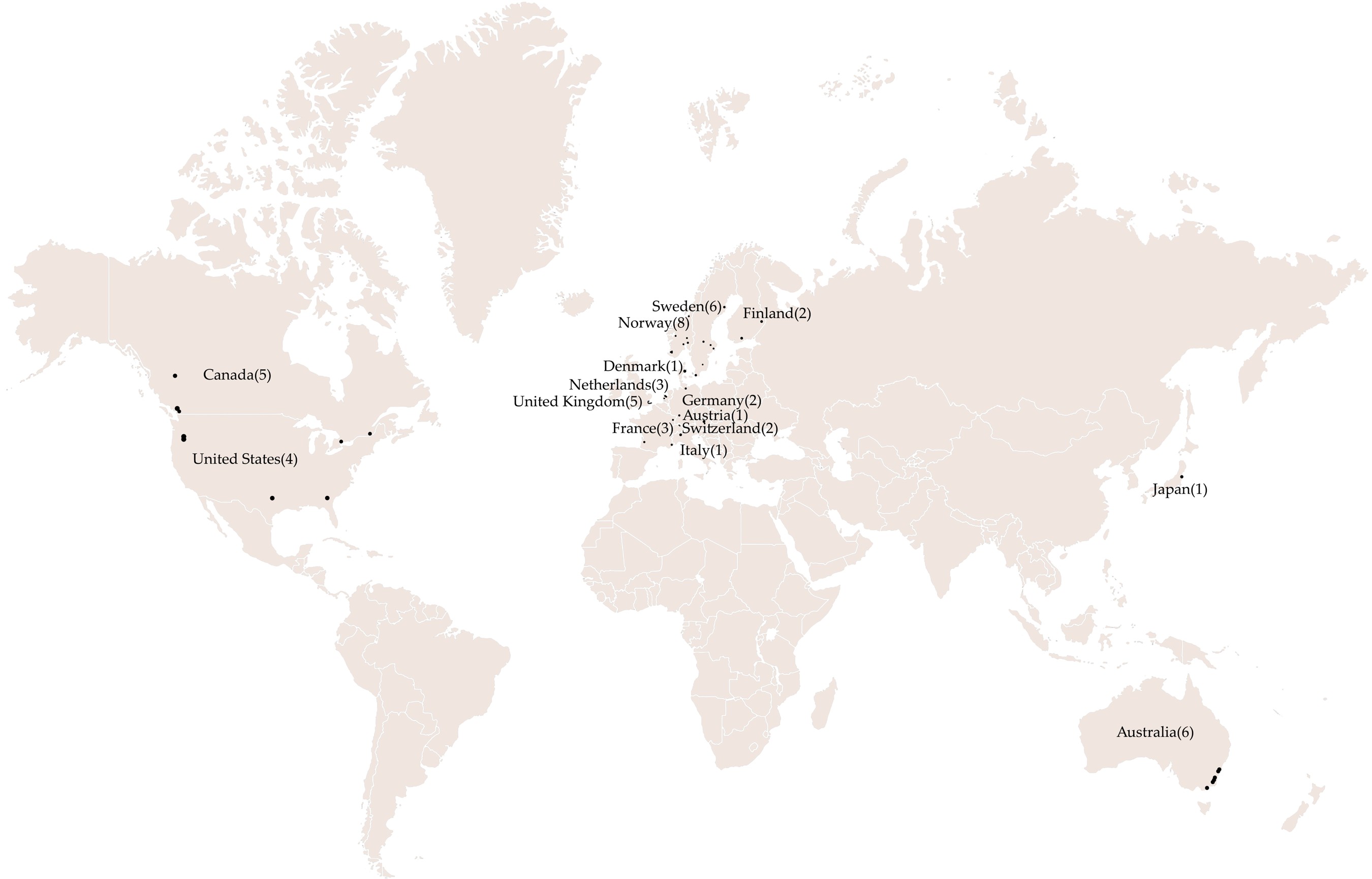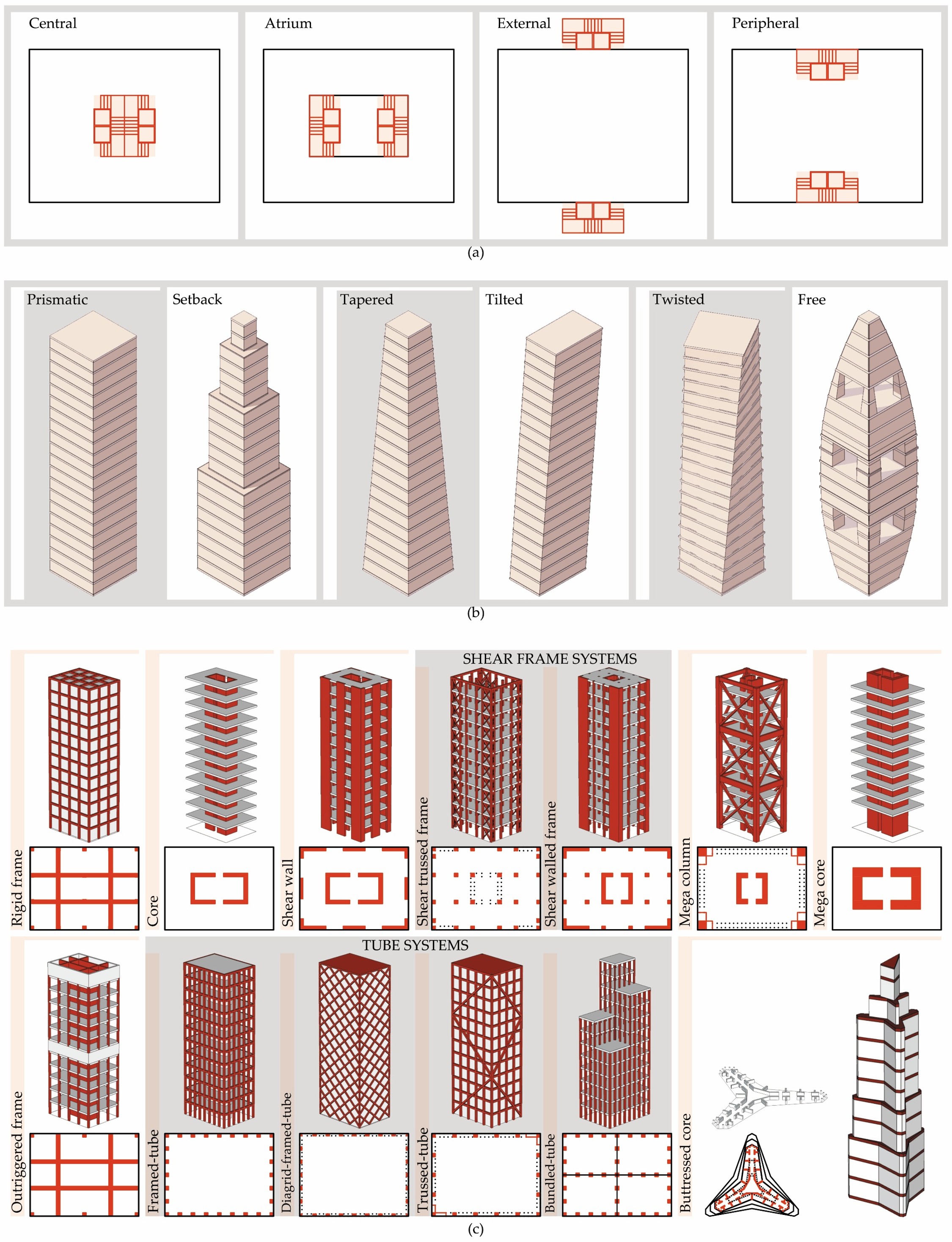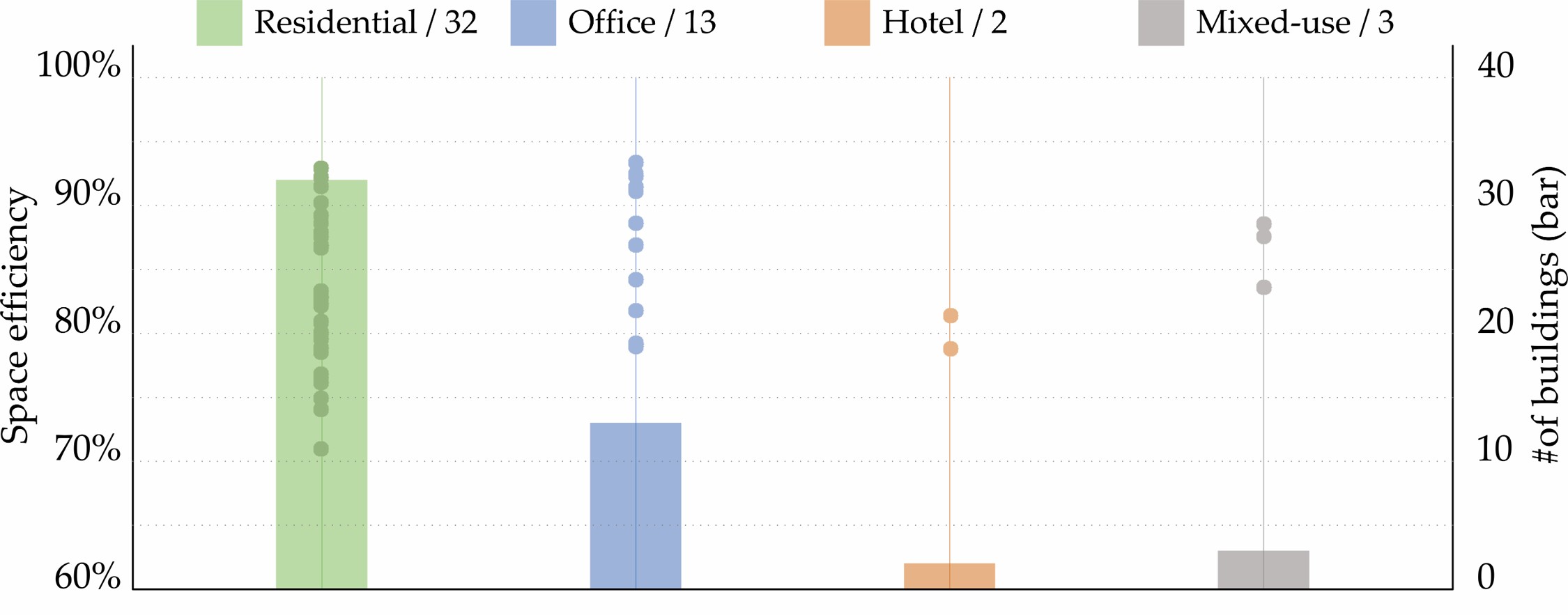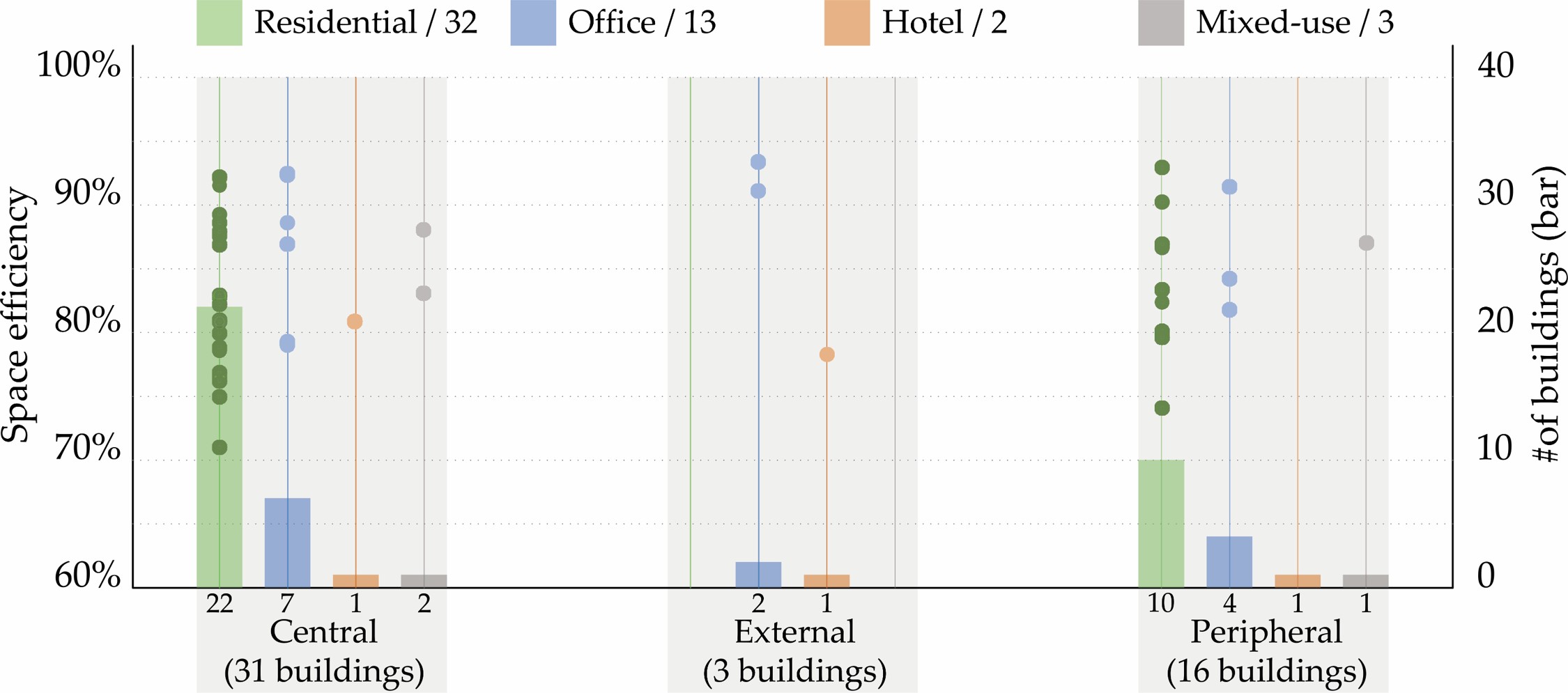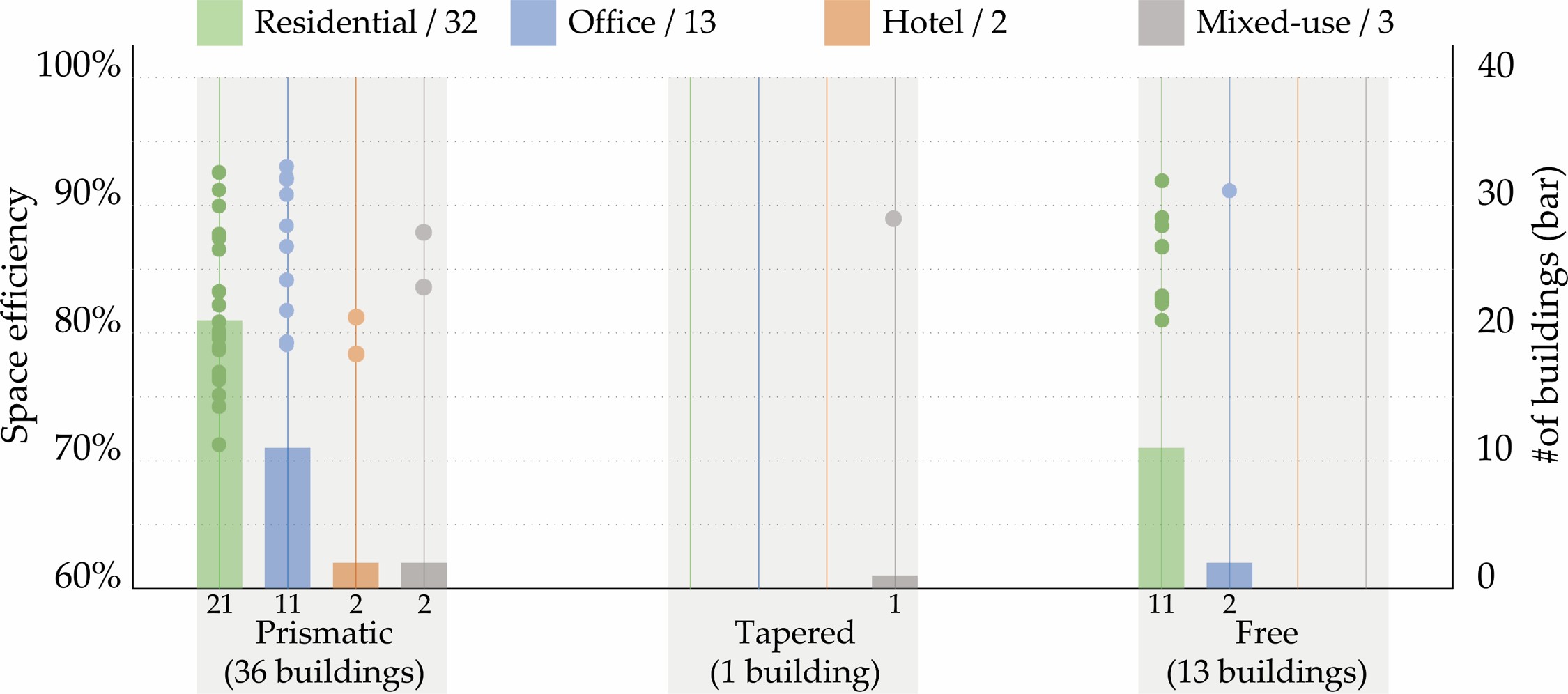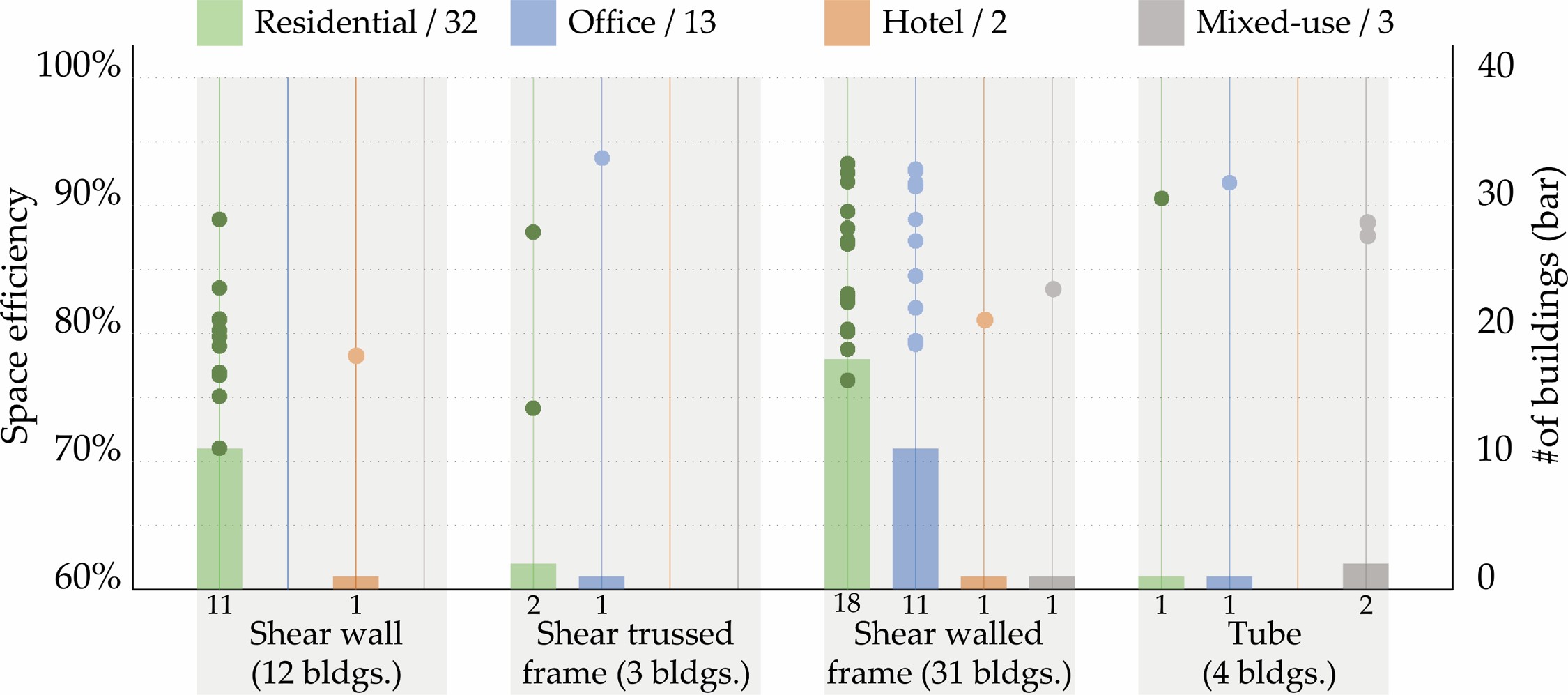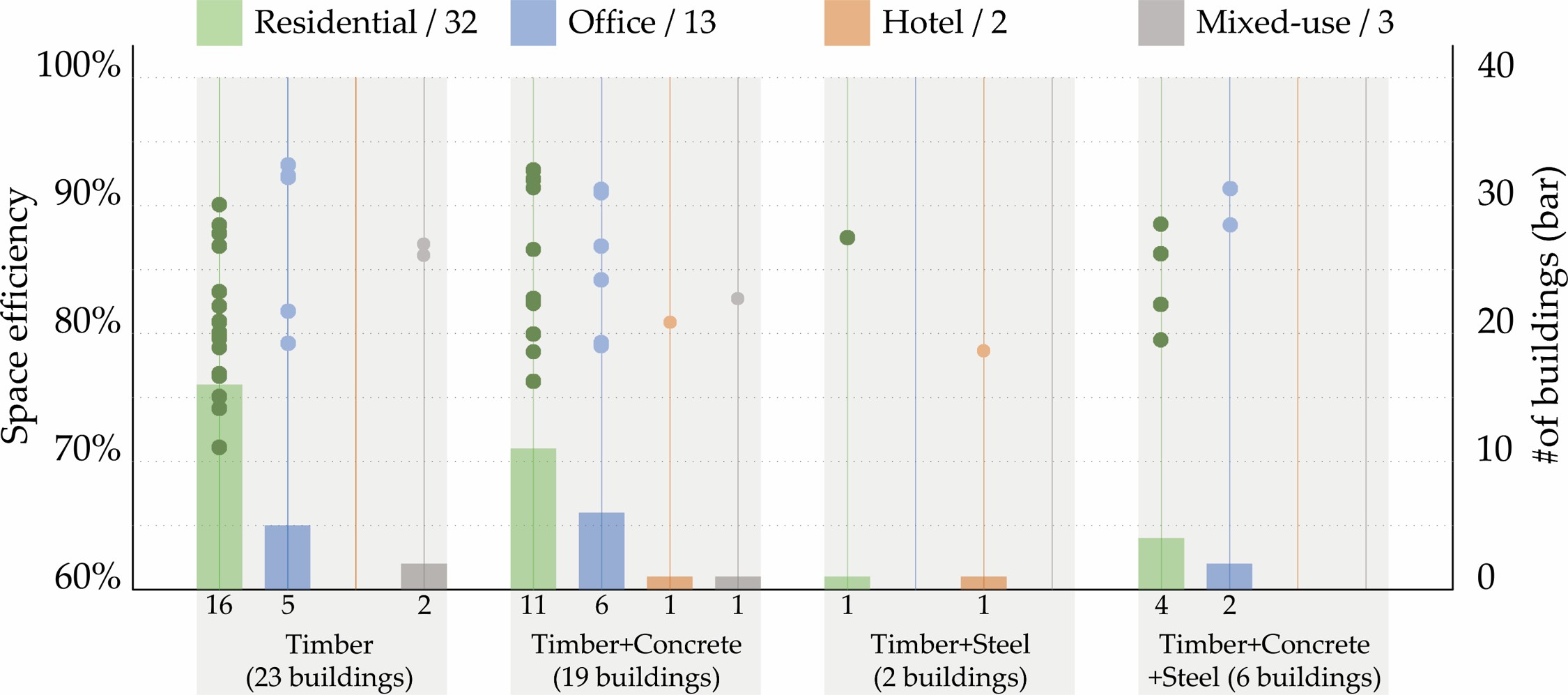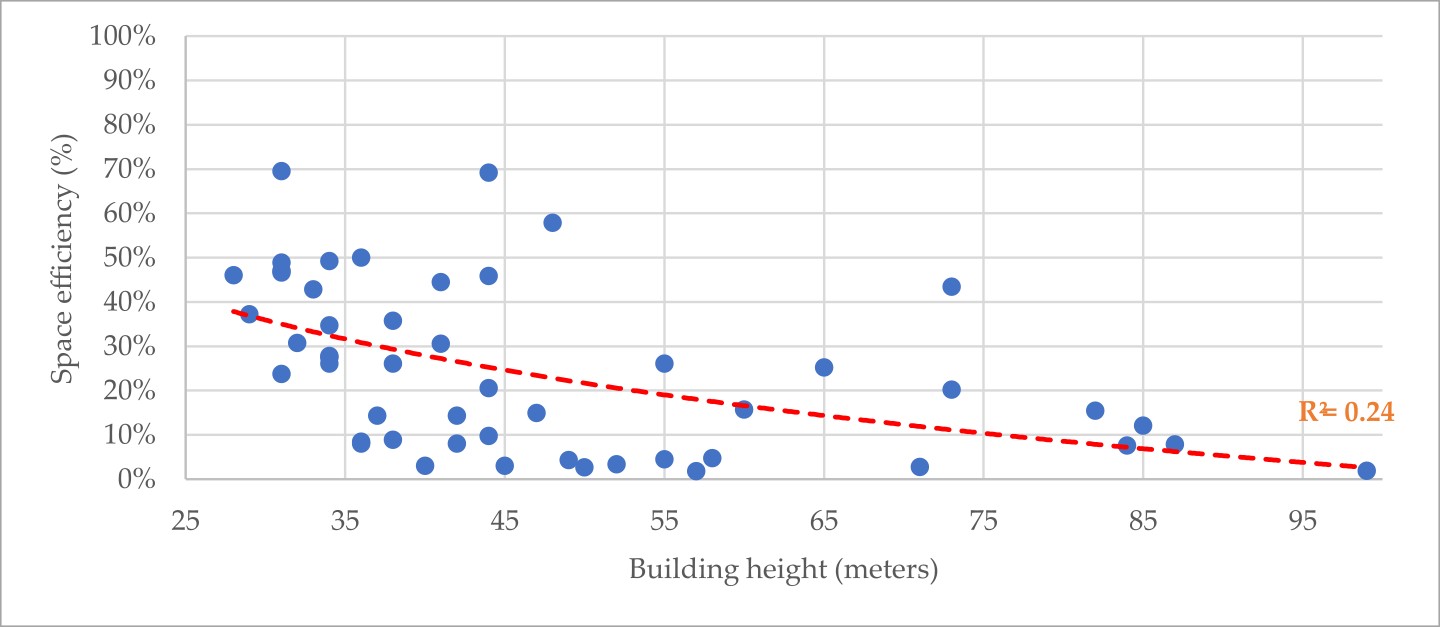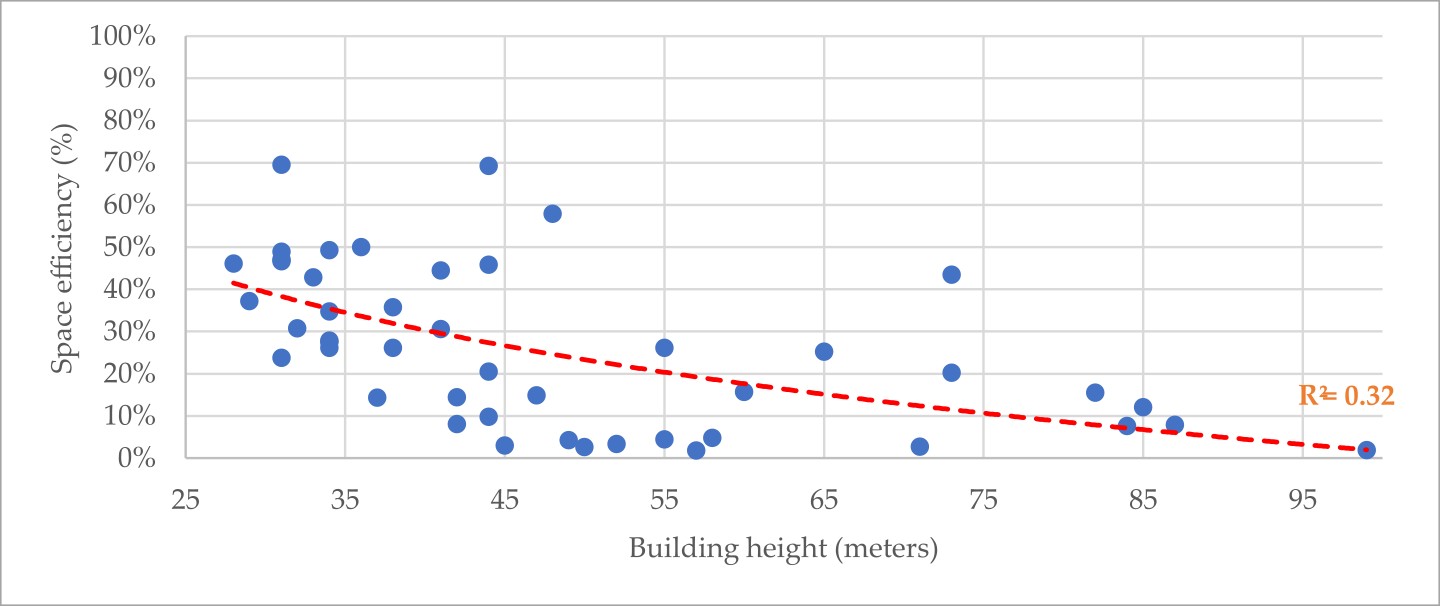Indexing: Web of Science (ESCI), Scopus (CiteScore: 1.2)
Review Peer-Reviewed
Space Efficiency in Tall Timber Buildings: A Comprehensive Review
1
School of Architecture, Faculty of Built Environment, Tampere University, 33720 Tampere, Finland
2
Department of Interior Architecture and Environmental Design, Faculty of Art, Design and Architecture, Atılım University, Ankara, Turkey
†
These authors contributed equally to this work.
*
For correspondence.
Academic Editor:
Received: 18 December 2024 Accepted: 2 May 2025 Published: 21 May 2025
Abstract
Tall timber construction is gaining popularity due to its notable environmental and economic benefits throughout its lifecycle. Maximizing space efficiency in these buildings is a key factor in ensuring project viability. However, there has been a lack of comprehensive research on the space efficiency of these projects. This study focused on analyzing 50 tall buildings (over eight stories) globally to improve insights into the design elements that affect space use. The key findings include: i) predominant architectural configurations incorporate residential functions, a centrally positioned core, and prismatic building forms; ii) composite materials are the most utilized, with shear-walled frame systems being the preferred structural solution; and iii) average space efficiency is 84%, with core areas accounting for 11% of the gross floor area, ranging from 71% and 4% at the lower end to 93% and 21% at the upper end. This study provides valuable guidance for architects and other key participants engaged in the planning and construction of tall timber buildings.
Figures in this Article
Would you like to reuse the images? Contact the journal editorial office to obtain high-quality versions.
Keywords
Copyright © 2025
Ilgın and Aslantamer. This article is distributed under the terms of the Creative Commons Attribution License (CC BY 4.0), which permits unrestricted use and distribution provided that the original work is properly cited.
Funding
This research received no specific grant from any funding agency in the public, commercial, or not-for-profit sectors.
Cite this Article
Ilgın, H. E., & Aslantamer, Ö. N. (2025). Space Efficiency in Tall Timber Buildings: A Comprehensive Review. Highlights of Sustainability, 4(2), 122–145. https://doi.org/10.54175/hsustain4020008
References
1.
Tupėnaitė, L., Žilėnaitė, V., Kanapeckienė, L., Sajjadian, S. M., Gečys, T., Sakalauskienė, L., et al. (2019). Multiple criteria assessment of high-rise timber buildings. Engineering Structures and Technologies, 11(3), 87–94. https://doi.org/10.3846/est.2019.11952
2.
Lafortezza, R., & Sanesi, G. (2019). Nature-based solutions: Settling the issue of sustainable urbanization. Environmental Research, 172, 394–398. https://doi.org/10.1016/j.envres.2018.12.063
3.
Bibri, S. E., & Krogstie, J. (2020). Environmentally data-driven smart sustainable cities: Applied innovative solutions for energy efficiency, pollution reduction, and urban metabolism. Energy Informatics, 3(1), 29. https://doi.org/10.1186/s42162-020-00130-8
4.
Mazutis, D., & Sweet, L. (2022). The business of accelerating sustainable urban development: A systematic review and synthesis. Journal of Cleaner Production, 357, 131871. https://doi.org/10.1016/j.jclepro.2022.131871
5.
Tupenaite, L., Zilenaite, V., Kanapeckiene, L., Gecys, T., & Geipele, I. (2021). Sustainability Assessment of Modern High-Rise Timber Buildings. Sustainability, 13(16), 8719. https://doi.org/10.3390/su13168719
6.
Goubran, S., Masson, T., & Walker, T. (2020). Diagnosing the local suitability of high-rise timber construction. Building Research & Information, 48(1), 101–123. https://doi.org/10.1080/09613218.2019.1631700
7.
Cover, J. (2020). Mass timber: The new sustainable choice for tall buildings. International Journal of High-Rise Buildings, 9(1), 87–93. https://doi.org/10.21022/IJHRB.2020.9.1.87
8.
Žegarac Leskovar, V., & Premrov, M. (2021). A Review of Architectural and Structural Design Typologies of Multi-Storey Timber Buildings in Europe. Forests, 12(6), 757. https://doi.org/10.3390/f12060757
9.
Kuys, B., & Mridha, M. (2024). Aesthetic Preference of Timber Joints in Architectural Products. Sustainability, 16(1), 154. https://doi.org/10.3390/su16010154
10.
Tenório, M., Ferreira, R., Belafonte, V., Sousa, F., Meireis, C., Fontes, M., et al. (2024). Contemporary Strategies for the Structural Design of Multi-Story Modular Timber Buildings: A Comprehensive Review. Applied Sciences, 14(8), 3194. https://doi.org/10.3390/app14083194
11.
Correa, D., Krieg, O. D., & Meyboom, A. (2019). Beyond form definition: Material informed digital fabrication in timber construction. In F. Bianconi & M. Filippucci (Eds.), Digital Wood Design: Innovative Techniques of Representation in Architectural Design (pp. 61–92). Springer, Cham. https://doi.org/10.1007/978-3-030-03676-8_2
12.
Sterley, M., Serrano, E., & Källander, B. (2021). Building and construction: Timber engineering and wood-based products. In Adhesive bonding (pp. 571–603). Woodhead Publishing. https://doi.org/10.1016/B978-0-12-819954-1.00021-6
13.
Sandberg, D., Gorbacheva, G., Lichtenegger, H., Niemz, P., & Teischinger, A. (2023). Advanced Engineered Wood-Material Concepts. In Springer Handbook of Wood Science and Technology (pp. 1835–1888). Springer, Cham. https://doi.org/10.1007/978-3-030-81315-4_35
14.
Fasasi, M. O. (2024). Assessing the Impact of Engineered Wood Products on Sustainable Construction: A Comparative Study with Conventional Concrete Building Methods. Open Journal of Engineering Science, 5, 1–13. https://doi.org/10.52417/ojes.v5i1.588
15.
Blanchet, P., Perez, C., & Cabral, M. R. (2024). Wood building construction: trends and opportunities in structural and envelope systems. Current Forestry Reports, 10, 21–38. https://doi.org/10.1007/s40725-023-00196-z
16.
Aleksandr, C., Tatiana, B., Viktor, T., & Anton, K. (2023). On the possibility of using timber structures in the construction of high-rise buildings in seismic areas. Architecture and Engineering, 8, 60–70. https://doi.org/10.23968/2500-0055-2023-8-1-60-70
17.
Ciabattoni, M., Petrini, F., & Pampanin, S. (2024). Multi-hazard design of low-damage high-rise steel–timber buildings subjected to wind and earthquake loading. Engineering Structures, 303, 117522. https://doi.org/10.1016/j.engstruct.2024.117522
18.
Ussher, E., Aloisio, A., & Rathy, S. (2023). Effect of lateral resisting systems on the wind-induced serviceability response of tall timber buildings. Case Studies in Construction Materials, 19, e02540. https://doi.org/10.1016/j.cscm.2023.e02540
19.
Adelzadeh, A., Karimian-Aliabadi, H., Åhlund, K., & Robeller, C. (18–23 September 2023). ReciprocalShell: A hybrid timber system for robotically-fabricated lightweight shell structures. The 41st Conference on Education and Research in Computer Aided Architectural Design in Europe (eCAADe 2023), Graz, Austria.
20.
Pastori, S., Mazzucchelli, E. S., & Wallhagen, M. (2022). Hybrid timber-based structures: A state of the art review. Construction and Building Materials, 359, 129505. https://doi.org/10.1016/j.conbuildmat.2022.129505
21.
Casagrande, D., Sinito, E., Izzi, M., Pasetto, G., & Polastri, A. (2021). Structural performance of a hybrid timber wall system for emergency housing facilities. Journal of Building Engineering, 33, 101566. https://doi.org/10.1016/j.jobe.2020.101566
22.
Scouse, A., Kelley, S. S., Liang, S., & Bergman, R. (2020). Regional and net economic impacts of high-rise mass timber construction in Oregon. Sustainable Cities and Society, 61, 102154. https://doi.org/10.1016/j.scs.2020.102154
23.
Piette, M. A., Diamond, R., Selkowitz, S., de la Rue du Can, S., Hong, T., Sun, K., et al. (2021). Global Opportunities and Challenges in Energy and Environmental Issues in the Buildings Sector. In Energy Efficiency: Innovations: Driving Prosperity, Slashing Emissions (pp. 31–132). World Scientific Publishing.
24.
Orta Rial, M. B., Martínez Gayá, J. E., Cervera Bravo, J., & Aira Zunzunegui, J. R. (2020). Timber high rise, state of the art. Informes de la Construcción, 72(558), e346. https://doi.org/10.3989/ic.71578
25.
Gu, H., Liang, S., & Bergman, R. (2020). Comparison of building construction and life-cycle cost for a high-rise mass timber building with its concrete alternative. Forest Products Journal, 70(4), 482–492. https://doi.org/10.13073/FPJ-D-20-00052
26.
Švajlenka, J., & Kozlovská, M. (2020). Evaluation of the efficiency and sustainability of timber-based construction. Journal of Cleaner Production, 259, 120835. https://doi.org/10.1016/j.jclepro.2020.120835
27.
Ahmed, S., & Arocho, I. (2021). Analysis of cost comparison and effects of change orders during construction: Study of a mass timber and a concrete building project. Journal of Building Engineering, 33, 101856. https://doi.org/10.1016/j.jobe.2020.101856
28.
Wagner, H. J., Alvarez, M., Groenewolt, A., & Menges, A. (2020). Towards digital automation flexibility in large-scale timber construction: integrative robotic prefabrication and co-design of the BUGA Wood Pavilion. Construction Robotics, 4(3), 187–204. https://doi.org/10.1007/s41693-020-00038-5
29.
Cheng, Z., Tang, S., Liu, H., & Lei, Z. (2023). Digital Technologies in Offsite and Prefabricated Construction: Theories and Applications. Buildings, 13(1), 163. https://doi.org/10.3390/buildings13010163
30.
Monizza, G. P., Di Blasio, I., & Matt, D. T. (2024). Exploring applications of Computational Design techniques and Design for Manufacturability for costs reduction of prefabricated timber-based facades: The ‘LegnAttivo’ design prototype. Developments in the Built Environment, 19, 100489. https://doi.org/10.1016/j.dibe.2024.100489
31.
Zhang, Y., Su, Z., Ni, W., Zhang, X., & Wang, L. (2024). Experimental study and theoretical analysis of fire resistance properties of prestressed glued laminated timber beams. Construction and Building Materials, 424, 135967. https://doi.org/10.1016/j.conbuildmat.2024.135967
32.
Deepa, M. S., Shukla, S. R., & Kelkar, B. U. (2024). Overview of applications of near infrared (NIR) spectroscopy in wood science: recent advances and future prospects. Journal of the Indian Academy of Wood Science, 21, 34–57. https://doi.org/10.1007/s13196-024-00334-5
33.
Khramov, I., & Aun, D. (2024). Selection of controlled parameters of the technological process of obtaining CLT panels with increased sound insulation. ITM Web of Conferences, 59, 01001. E https://doi.org/10.1051/itmconf/20245901001
34.
Michalak, H., & Michalak, K. (2024). Selected Aspects of Sustainable Construction—Contemporary Opportunities for the Use of Timber in High and High-Rise Buildings. Energies, 17(8), 1961. https://doi.org/10.3390/en17081961
35.
Ascione, F., Esposito, F., Iovane, G., Faiella, D., Faggiano, B., & Mele, E. (2024). Sustainable and Efficient Structural Systems for Tall Buildings: Exploring Timber and Steel-Timber Hybrids through a Case Study. Buildings, 14(2), 524. https://doi.org/10.3390/buildings14020524
36.
Ahmed, D., Dernayka, S., R. Chowdhury, S., Asiz, A., & Ayadat, T. (2024). Sustainable timber building and its carbon emission analysis in the LINE-NEOM. Mechanics of Advanced Materials and Structures, 31(26), 8682–8690. https://doi.org/10.1080/15376494.2023.2262978
37.
Nguyen, L. P., van den Berg, P. E., Kemperman, A. D., & Mohammadi, M. (2024). Social impacts of living in high-rise apartment buildings: The effects of buildings and neighborhoods. Journal of Urban Affairs, 1–22. https://doi.org/10.1080/07352166.2024.2311165
38.
Whyte, S., Kaburagi, R., Gan, V., Candido, C., Avazpour, B., Fatourehchi, D., et al. (2024). Exploring the Benefits of Mass Timber Construction in the Workplace: A Novel Primer for Research. Buildings, 14(7), 2072. https://doi.org/10.3390/buildings14072072
39.
Altomonte, S., Allen, J., Bluyssen, P. M., Brager, G., Heschong, L., Loder, A., et al. (2020). Ten questions concerning well-being in the built environment. Building and Environment, 180, 106949. https://doi.org/10.1016/j.buildenv.2020.106949
40.
Pinaykin, I. P., Zhadanov, V. I., & Ukrainchenko, D. A. (2021). Wooden low-rise construction. New constructive and technological solutions. IOP Conference Series: Earth and Environmental Science, 751, 012092. https://doi.org/10.1088/1755-1315/751/1/012092
41.
Ilgın, H. E., Karjalainen, M., & Pelsmakers, S. (2024). Finnish architects’ attitudes towards multi-storey timber-residential buildings. International Journal of Building Pathology and Adaptation, 42(3), 352–368. https://doi.org/10.1108/IJBPA-04-2021-0059
42.
Marfella, G., & Winson-Geideman, K. (2021). Timber and Multi-Storey Buildings: Industry Perceptions of Adoption in Australia. Buildings, 11(12), 653. https://doi.org/10.3390/buildings11120653
43.
Gilbert, B., Skitmore, M., Ali, Y., & Gray, J. (2020). Key considerations of cross-laminated timber (CLT) for high-rise construction in Australia: A review. Journal of Real Estate, Construction & Management, 35, 70–81. https://doi.org/10.1177/2977657020200107
44.
Tulonen, L., Karjalainen, M., & Ilgin, H. E. (2021). Tall wooden residential buildings in Finland: What are the key factors for design and implementation? In Engineered Wood Products for Construction. InTech Open. https://doi.org/10.5772/intechopen.98781
45.
Ilgın, H. E. (2024). Analysis of the Main Architectural and Structural Design Considerations in Tall Timber Buildings. Buildings, 14(1), 43. https://doi.org/10.3390/buildings14010043
46.
Karjalainen, M., Ilgın, H. E., & Tulonen, L. (2021). Main Design Considerations and Prospects of Contemporary Tall Timber Apartment Buildings: Views of Key Professionals from Finland. Sustainability, 13(12), 6593. https://doi.org/10.3390/su13126593
47.
Maithani, P., & Mishra, K. (2024). Sustainability in Structure: Innovations in Engineered Wood Products for Green Building. In Encyclopedia of Green Materials (pp. 1–7). Springer, Singapore. https://doi.org/10.1007/978-981-16-4921-9_292-1
48.
Gibson, A., & Pomponi, F. (2025). The Impact of Forest Management Success Rates on the Net Carbon Benefits of Using Timber in Construction. Sustainability, 17(5), 1919. https://doi.org/10.3390/su17051919
49.
Salonvaara, M., & Desjarlais, A. (2024). Impact of Insulation Strategies of Cross-Laminated Timber Assemblies on Energy Use, Peak Demand, and Carbon Emissions. Buildings, 14(4), 1089. https://doi.org/10.3390/buildings14041089
50.
Premrov, M., & Žegarac Leskovar, V. (2023). Innovative Structural Systems for Timber Buildings: A Comprehensive Review of Contemporary Solutions. Buildings, 13(7), 1820. https://doi.org/10.3390/buildings13071820
51.
Lubloy, E., Takács, L. G., Enczel, D. I., & Cimer, Z. (2021). Examination of the effect of fire retardant materials on timber. Journal of Structural Fire Engineering, 12(4), 429–445. https://doi.org/10.1108/JSFE-11-2020-0036
52.
Ilgın, H. E., Karjalainen, M., Alanen, M., & Malaska, M. (2023). Evaluating Fire Performance: An Experimental Comparison of Dovetail Massive Wooden Board Elements and Cross-Laminated Timber. Fire, 6(9), 352. https://doi.org/10.3390/fire6090352
53.
Strang, M., Leardini, P., Brambilla, A., & Gasparri, E. (2021). Mass Timber Envelopes in Passivhaus Buildings: Designing for Moisture Safety in Hot and Humid Australian Climates. Buildings, 11(10), 478. https://doi.org/10.3390/buildings11100478
54.
Ilgın, H. E., Haapaniemi, S., Karjalainen, M., & Vinha, J. (2024). Measurement of air permeance in mass timber elements assembled through the dovetail technique. Journal of Building Engineering, 94, 110009. https://doi.org/10.1016/j.jobe.2024.110009
55.
Iqbal, A. (2021). Developments in Tall Wood and Hybrid Buildings and Environmental Impacts. Sustainability, 13(21), 11881. https://doi.org/10.3390/su132111881
56.
Rinne, R., Ilgın, H. E., & Karjalainen, M. (2022). Comparative study on life-cycle assessment and carbon footprint of hybrid, concrete and timber apartment buildings in Finland. International Journal of Environmental Research and Public Health, 19(2), 774. https://doi.org/10.3390/ijerph19020774
57.
Zhao, X., Liu, Y., Zhao, L., Yazdkhasti, A., Mao, Y., Siciliano, A. P., et al. (2023). A scalable high-porosity wood for sound absorption and thermal insulation. Nature Sustainability, 6(3), 306–315. https://doi.org/10.1038/s41893-022-01035-y
58.
Zeug, W., Bezama, A., & Thrän, D. (2021). A framework for implementing holistic and integrated life cycle sustainability assessment of regional bioeconomy. The International Journal of Life Cycle Assessment, 26, 1998–2023. https://doi.org/10.1007/s11367-021-01983-1
59.
Ilgın, H. E., & Karjalainen, M. (2022). Tallest Timber Buildings: Main Architectural and Structural Design Considerations. In Wood Industry-Past, Present and Future Outlook. IntechOpen.
60.
Chen, F., Li, M., & Li, Z. (2024). Self-centering mass timber structures: A review on recent research progress. Engineering Structures, 303, 117474. https://doi.org/10.1016/j.engstruct.2024.117474
61.
Ilgın, H.E.; Karjalainen, M.; Koponen, O. Dovetailed Massive Wood Board Elements for Multi-Story Buildings. LIVENARCH VII-2021. Livable Environments and Architecture International Congress. Other Architect/ure(s), Trabzon, Turkey.
62.
Pan, Y., An, R., You, W., & Fan, Y. (2024). A mechanical model used for the multifactor analysis of through-tenon joints in traditional Chinese timber structures. International Journal of Architectural Heritage, 18(4), 551–576. https://doi.org/10.1080/15583058.2023.2173106
63.
Ilgın, H. E., & Aslantamer, Ö. N. (2024). Analysis of Space Efficiency in High-Rise Timber Residential Towers. Applied Sciences, 14(11), 4337. https://doi.org/10.3390/app14114337
64.
Aslantamer, Ö. N., & Ilgın, H. E. (2024). Space efficiency in timber office buildings. Journal of Building Engineering, 91, 109618. https://doi.org/10.1016/j.jobe.2024.109618
65.
Tuure, A., & Ilgın, H. E. (2023). Space Efficiency in Finnish Mid-Rise Timber Apartment Buildings. Buildings, 13(8), 2094. https://doi.org/10.3390/buildings13082094
66.
Ilgın, H. E. (2023). A study on space efficiency in contemporary supertall mixed-use buildings. Journal of Building Engineering, 69, 106223. https://doi.org/10.1016/j.jobe.2023.106223
67.
Ilgın, H. E. (2021). Space Efficiency in Contemporary Supertall Residential Buildings. Architecture, 1(1), 25–37. https://doi.org/10.3390/architecture1010004
68.
Emre Ilgın, H. (2021). Space efficiency in contemporary supertall office buildings. Journal of Architectural Engineering, 27(3), 04021024. https://doi.org/10.1061/(ASCE)AE.1943-5568.0000486
69.
Ilgın, H. E. (2023). An analysis of space efficiency in Asian supertall towers. International Journal of Building Pathology and Adaptation, 41(6), 237–253. https://doi.org/10.1108/IJBPA-06-2023-0082
70.
Ilgın, H. E. (2025). Examination of spatial efficiency in super-tall towers within the Middle Eastern context. Open House International, 50(1), 191–208. https://doi.org/10.1108/OHI-11-2023-0263
71.
Aslantamer, Ö. N., & Ilgın, H. E. (2024). Space Efficiency in Tall Hotel Towers. Buildings, 14(7), 2051. https://doi.org/10.3390/buildings14072051
72.
Aslantamer, Ö. N., & Ilgın, H. E. (2024). Evaluating Space Efficiency of Tall Buildings in Turkey. Buildings, 14(7), 2138. https://doi.org/10.3390/buildings14072138
73.
Ilgın, H. E., & Aslantamer, Ö. N. (2024). Investigating Space Utilization in Skyscrapers Designed with Prismatic Form. Buildings, 14(5), 1295. https://doi.org/10.3390/buildings14051295
74.
Ilgın, H. E. (2023). Space Efficiency in Tapered Super-Tall Towers. Buildings, 13(11), 2819. https://doi.org/10.3390/buildings13112819
75.
Okbaz, F. T., & Sev, A. (2023). A model for determining the space efficiency in non-orthogonal high rise office buildings. Journal of the Faculty of Engineering and Architecture of Gazi University, 38, 113–125.
76.
Ibrahimy, R., Mohmmand, M. A., & Elham, F. A. (2023). An Evaluation of Space Use Efficiency in Residential Houses, Kabul City. Journal for Research in Applied Sciences and Biotechnology, 2, 1–6. https://doi.org/10.55544/jrasb.2.3.1
77.
Hamid, G. M., Elsawi, M., & Yusra, O. (2022). The Impacts of Spatial Parameters on Space Efficiency in Hybrid Villa-Apartments in Greater Khartoum, Sudan. Journal of Architecture and Planning, 34, 425–440.
78.
Suga, R. (2021). Space Efficiency in Hotel Development [Master’s Thesis]. MODUL University Vienna.
79.
Goessler, T., & Kaluarachchi, Y. (2023). Smart Adaptive Homes and Their Potential to Improve Space Efficiency and Personalisation. Buildings, 13(5), 1132. https://doi.org/10.3390/buildings13051132
80.
Arslan Kılınç, G. (2019). Improving a Model for Determining Space Efficiency of Tall Office Buildings [Ph.D. Thesis] (in Turkish). Mimar Sinan Fine Art University.
81.
Sev, A., & Özgen, A. (2009). Space efficiency in high-rise office buildings. METU Journal of the Faculty of Architecture, 26, 69–89. https://doi.org/10.4305/metu.jfa.2009.2.4
82.
Kim, H., & Elnimeiri, M. (10–13 October 2004). Space efficiency in multi-use tall building. The Tall Buildings in Historical Cities-Culture and Technology for Sustainable Cities, Seoul, Republic of Korea.
83.
Höjer, M., & Mjörnell, K. (2018). Measures and Steps for More Efficient Use of Buildings. Sustainability, 10(6), 1949. https://doi.org/10.3390/su10061949
84.
Nam, H. J., & Shim, J. H. (2016). An analysis of the change in space efficiency based on various tall building corner shapes and lease spans. Journal of the Architectural Institute of Korea Planning & Design, 32(8), 13–20.
85.
Zhang, L., Zhang, L., & Wang, Y. (2016). Shape optimization of free-form buildings based on solar radiation gain and space efficiency using a multi-objective genetic algorithm in the severe cold zones of China. Solar Energy, 132, 38–50. https://doi.org/10.1016/j.solener.2016.02.053
86.
Saari, A., Tissari, T., Valkama, E., & Seppänen, O. (2006). The effect of a redesigned floor plan, occupant density and the quality of indoor climate on the cost of space, productivity and sick leave in an office building—A case study. Building and Environment, 41(12), 1961–1972. https://doi.org/10.1016/j.buildenv.2005.07.012
87.
Von Both, P. (2019). A stakeholder-and function-based planning method for space-efficient buildings. IOP Conference Series: Earth and Environmental Science, 323, 012040. https://doi.org/10.1088/1755-1315/323/1/012040
88.
Lee, R., Kim, D., Yoon, J., Kang, E., Cho, H., & Kim, J. (2024). Development and calibration of apartment building energy model based on architectural and energy consumption characteristics. Renewable and Sustainable Energy Reviews, 206, 114874. https://doi.org/10.1016/j.rser.2024.114874
89.
Yeang, K. (2000). Service Cores: Detail in Building. Wiley-Academy.
90.
Attia, S. (2018). Net Zero Energy Buildings (NZEB): Concepts, frameworks and roadmap for project analysis and implementation. Butterworth-Heinemann.
91.
Wang, P., Yang, Y., Ji, C., & Huang, L. (2024). Influence of built environment on building energy consumption: a case study in Nanjing, China. Environment, Development and Sustainability, 26(2), 5199–5222. https://doi.org/10.1007/s10668-023-02930-w
92.
Ilgın, H. E. (2022). Use of aerodynamically favorable tapered form in contemporary supertall buildings. Journal of Design for Resilience in Architecture and Planning, 3(2), 183–196.
93.
Miao, J. T., Aritenang, A. F., & Gissma, N. (2024). Smart city in the creativity-built environment nexus: A case study of Bandung. In Routledge Companion to Creativity and the Built Environment (pp. 435–447). Routledge.
94.
Carapellucci, F., Conti, V., Lelli, M., Liberto, C., Orchi, S., Valenti, G., et al. (2023). Tools and Methodologies for the Analysis of Home-to-Work Shuttle Service Impacts: The ENEA “Casaccia” Case Study. Future Transportation, 3(3), 901–917. https://doi.org/10.3390/futuretransp3030050
95.
Smith, I., & Frangi, A. (2008). Overview of design issues for tall timber buildings. Structural Engineering International, 18(2), 141–147. https://doi.org/10.2749/101686608784218833
96.
FWPA. (2017). Mid-rise timber buildings, class 2, 3 and 5 buildings. https://www.ctbuh.org (accessed 21 April 2025).
97.
Ilgın, H. E., Karjalainen, M., & Pelsmakers, S. (2023). Contemporary tall residential timber buildings: what are the main architectural and structural design considerations? International Journal of Building Pathology and Adaptation, 41(6), 26–46. https://doi.org/10.1108/IJBPA-10-2021-0142
98.
Calder, K., Senez, P., & McPhee, R. (2014). The risk basis for height and area limits in North American building codes. In Proceedings of World Conference on Timber Engineering (WTCE) 2014 (pp. 10–14). Canadian Wood Council.
99.
Kohn, A. E., & Katz, P. (2002). Building type basics for office buildings. John Wiley & Sons.
100.
Trabucco, D. (2008). An analysis of the relationship between service cores and the embodied/running energy of tall buildings. The Structural Design of Tall and Special Buildings, 17(5), 941–952. https://doi.org/10.1002/tal.477
101.
Trabucco, D. (2010). Historical Evolution of the Service Core. CTBUH Journal, 42–47.
102.
Aldred, J. (2010). Burj Khalifa–a new high for high-performance concrete. In Proceedings of the Institution of Civil Engineers-Civil Engineering (Vol. 163, pp. 66–73). Thomas Telford.
103.
Marcus, S. (26–30 October 2015). The new supers: Super-slender towers of New York. The CTBUH 2015 International Conference «Global Interchanges: Resurgence of the Skyscraper City», New York, NY, USA.
104.
Hammoud, M., Baker, W., Scheeren, O., Parakh, J., Hean, C. K., Lochhead, H., et al. (2018). CTBUH 2018 Conference Special. CTBUH Journal, 44–51.
105.
Vollers, K. (3–5 March 2008). Morphological Scheme of Second-Generation Non-Orthogonal High-Rises. The 8th World Congress of the Council on Tall Buildings and Urban Habitat: Tall & Green: Typology for a Sustainable Urban Future, Post Congress Review, Dubai, United Arab Emirates.
106.
Al-Kodmany, K., & Ali, M. M. (2016). An overview of structural and aesthetic developments in tall buildings using exterior bracing and diagrid systems. International Journal of High-Rise Buildings, 5(4), 271–291. https://doi.org/10.21022/IJHRB.2016.5.4.271
107.
Schueller, W. (1977). High-Rise Building Structures. Wiley.
108.
Smith, B. S., & Coull, A. (1991). Tall Building Structures: Analysis and Design. Wiley.
109.
Taranath, B. (1998). Steel, Concrete & Composite Design of Tall Buildings. McGraw-Hill Book.
110.
Ali, M. M., & Moon, K. S. (2007). Structural developments in tall buildings: current trends and future prospects. Architectural Science Review, 50(3), 205–223. https://doi.org/10.3763/asre.2007.5027
111.
Baker, W. F., Brown, C. D., Young, B. S., & Zachrison, E. (2010). Infinity Tower, Dubai, UAE. In Structures Congress 2010 (pp. 3078–3087). American Society of Civil Engineers. https://doi.org/10.1061/41130(369)276
112.
Ali, M. M., & Moon, K. S. (2018). Advances in Structural Systems for Tall Buildings: Emerging Developments for Contemporary Urban Giants. Buildings, 8(8), 104. https://doi.org/10.3390/buildings8080104
113.
Moon, K. S. (2018). Developments of structural systems toward mile-high towers. International Journal of High-Rise Buildings, 7(3), 197–214. https://doi.org/10.21022/IJHRB.2018.7.3.197
114.
Fu, F. (2018). Design and Analysis of Tall and Complex Structures. Butterworth-Heinemann.
115.
Ilgın, H. E. (2022). Core Design and Space Efficiency in Contemporary Supertall Office Buildings. In Sustainable High-Rise Buildings: Design, Technology, and Innovation. The Institution of Engineering and Technology.
116.
Building Owners and Managers Association (BOMA). (n.d.). BOMA Homepage. https://www.boma.org (accessed 21 April 2025).
117.
Royal Institution of Chartered Surveyors (RICS). (n.d.). RICS Homepage. https://www.rics.org (accessed 21 April 2025).
118.
International Property Measurement Standards Coalition (IPMSC). (2022). International Property Measurement Standards: All Buildings. https://www.rics.org/profession-standards/rics-standards-and-guidance/sector-standards/real-estate-standards/international-property-measurement-standards (accessed 21 April 2025).
119.
Xie, Y., Du, P., & Luo, J. (2022). Hierarchical Quantification of Utilization Rate and Related Indicators of Mixed-Use High-Rise Buildings. Buildings, 12(7), 956. https://doi.org/10.3390/buildings12070956
120.
Vacek, Z., Vacek, S., & Cukor, J. (2023). European forests under global climate change: Review of tree growth processes, crises and management strategies. Journal of Environmental Management, 332, 117353. https://doi.org/10.1016/j.jenvman.2023.117353
121.
Matiiuk, Y., Krikštolaitis, R., & Liobikienė, G. (2023). The COVID-19 pandemic in context of climate change perception and resource-saving behavior in the European Union countries. Journal of Cleaner Production, 395, 136433. https://doi.org/10.1016/j.jclepro.2023.136433
122.
Ilgın, H. E., & Aslantamer, Ö. N. (2024). Comparative Analysis of Space Efficiency in Skyscrapers with Prismatic, Tapered, and Free Forms. Buildings, 14(11), 3345. https://doi.org/10.3390/buildings14113345
123.
Wang, W. (2020). Research on seismic design of high-rise buildings based on framed-shear structural system. Frontiers Research of Architecture and Engineering, 3(3), 87–90.
124.
Ilgin, E., & Aslantamer, Ö. N. (2024). Comparative analysis of space efficiency in contemporary tall buildings: Residential, office, hotel and mixed-use functions. International Journal of Architectural Engineering Technology, 11, 60–79.
125.
Abdulhadi, M., Xun’an, Z., Atroshchenko, E., & Rungamornrat, J. (2024). Vibration control of inerter-enhanced mega sub-controlled structure system (MSCSS) and the reliability analysis of the structure under seismic action. Engineering Structures, 304, 117508. https://doi.org/10.1016/j.engstruct.2024.117508
126.
Angelucci, G., Mollaioli, F., Molle, M., & Paris, S. (2022). Performance assessment of timber high-rise buildings: Structural and technological considerations. The Open Construction & Building Technology Journal, 16, 1–12.
127.
Binck, C., Cao, A. S., & Frangi, A. (2022). Lateral stiffening systems for tall timber buildings–tube-in-tube systems. Wood Material Science & Engineering, 17(4), 309–316. https://doi.org/10.1080/17480272.2022.2086066
128.
Stulen, J. (2019). The use of mass timber—An update. NZ Journal of Forestry, 64, 26–31.
129.
Aloisio, A., Pasca, D. P., De Santis, Y., Hillberger, T., Giordano, P. F., Rosso, M. M., et al. (2023). Vibration issues in timber structures: A state-of-the-art review. Journal of Building Engineering, 76, 107098. https://doi.org/10.1016/j.jobe.2023.107098
130.
Carrero, T., Montaño, J., Perez, L., Doudak, G., Santa María, H., Chacón, M. F., et al. (2024). New enhanced hybrid glulam-framed OSB wall for tall timber buildings. Structures, 70, 107770. https://doi.org/10.1016/j.istruc.2024.107770
Metrics
Loading...
Journal Menu
Journal Contact
Highlights of Sustainability
Editorial Office
Highlights of Science
Avenida Madrid, 189-195, 3-3
08014 Barcelona, Spain
08014 Barcelona, Spain
Cathy Wang
Managing Editor
